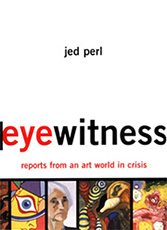in Eyewitness: Reports
From An Art World In Crisis
by Jed Perl

Basic Books, 2000
Who exactly are these artists who are not receiving the support that they need and deserve? I could name many, each a different case, each unable to receive a proper hearing. To begin, I want to point briefly to two: Barbara Goodstein and Stanley Lewis. Both are in their 50s; both have shown at small cooperative galleries in New York City for years. Goodstein is probably the most original sculptor of her generation The landscapes in her show at the Bowery Gallery in the spring of 1999 announced a new pastoral mode, a pastoral in which serenity seems to be wrenched form the jangling upheavals of modern life…
Goodstein’s sculpture is in low relief, and her technique is absolutely her own. She works in plaster on plywood boards, building up this wonderfully fluid material into forms that are a sculptor’s reconsideration of the traditions of painterly painting. Her subjects are the figure and the landscape, but everything in her works is simplified, reduced, so that what meets the eye is a sequence of iconic, telegraphic signs. A panoramic landscape is transformed into a couple of undulating arabesques. A house next to a tree is evoked with the deliberate brevity of Chinese calligraphy. Some of Goodstein’s finest figure pieces are variations on classical themes – the Three Graces, the Pietà – and here she seems to feel the pressure of the whole tradition pushing her forward. Often she paints the boards black or dark green, so that the pats and lines and jabs of plaster stand out like stars in a night sky. Her figures are summations,, abbreviations. The cycle of Three Graces is her memory of Raphael remembering Pompeii. Goodstein’s work, with its passionate mix of conventional sources and unconventional methods, is astonishingly concise.